After the total solar eclipse in the U.S., Google searches about “hurt eyes” spiked, indicating that some people may have been concerned about having looked at the sun for too long without protective equipment. Eye experts have confirmed that staring at the sun without proper protection can indeed cause harm to the vision, and there have been documented cases of eye issues after past eclipse events. However, instances of long-term damage following eclipses are not common. Injuries from “solar retinopathy,” caused when light injures the retinas, can occur without immediate pain, making it a serious concern.
There are two main types of injuries that can result from looking at the sun directly – a burn to the outer eye, and damage to the nerve tissue within. A burn to the surface of the eye, known as solar keratitis, can result in symptoms such as redness and tearing, but these typically resolve on their own within a day or two without causing permanent damage. While this type of injury is rare and more often seen in climbers at high altitudes without eye protection, it is still important to be cautious about any vision symptoms that may arise after viewing the eclipse.
If any symptoms like blind spots, wavy lines, floaters, or blurry vision occur after sun exposure, it could indicate solar retinopathy, and immediate medical attention is necessary. Solar retinopathy symptoms typically develop within 24 hours after sun exposure, but do not involve pain sensations due to the lack of pain receptors in the retina. Unfortunately, there is no specific treatment for solar retinopathy, and recovery may be slow and partial for some patients over time. Limited data suggests that prolonged problems from solar retinopathy are not common, with only around 100 cases reported after the 2017 total solar eclipse.
There is no national registry that keeps track of eye injuries related to eclipses, and after the 2017 eclipse, only a few cases were seen at a clinic in Seattle. Dr. Van Gelder treated several patients with eye complaints, two of whom had partial recoveries. It is emphasized that if there is any pain associated with eye issues following sun exposure, it may not be significant, but any vision problems should prompt immediate medical attention. It only takes a few seconds of unprotected exposure to the sun’s rays to cause eye damage, and people should not be misled by the apparent safety of looking at the sun during an eclipse when the moon is blocking it in totality and appears cloudy.
In conclusion, it is important to take proper precautions when viewing solar eclipses to avoid damaging the eyes, which can result in conditions like solar retinopathy. While cases of long-term damage are rare, any symptoms of vision issues should not be ignored and require prompt medical evaluation. The lack of pain sensation in the retina makes it difficult to detect early signs of eye damage from staring at the sun, underscoring the importance of protective eyewear and being vigilant about any symptoms that may arise after sun exposure during an eclipse event.


